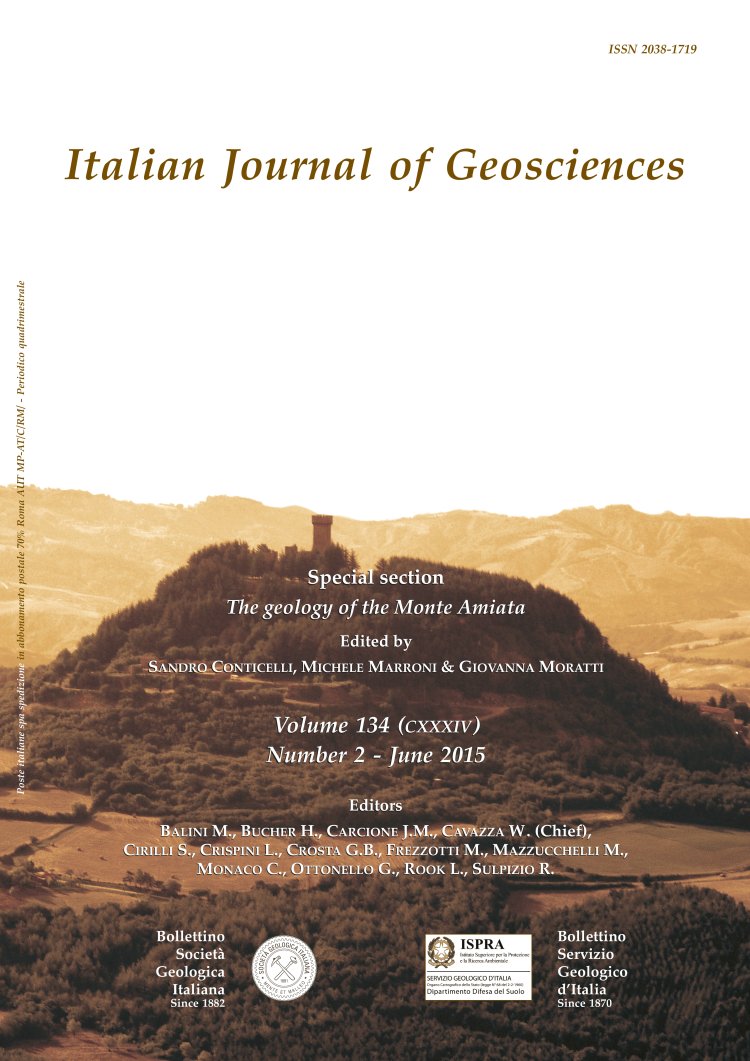
Updated picture of the Ligurian and Sub-Ligurian units in the Mt. Amiata area (Tuscany, Italy): elements for their correlation in the framework of the Northern Apennines
Michele Marroni (*), (***), Enrico Pandeli (**), (****), Luca Pandolfi (*), (***) & Rita Catanzariti (***)
(*) Dipartimento di Scienze della Terra, Università di Pisa. Via S. Maria, 53 - 56126 Pisa, Italy. Corresponding author: e-mail: marroni@dst.unipi.it
(**) Dipartimento di Scienze della Terra, Università di Firenze.
(***) Istituto di Geoscienze e Georisorse, CNR, Pisa.
(****) Istituto di Geoscienze e Georisorse, CNR, Florence.
DOI: https://doi.org/10.3301/IJG.2014.47
Volume: 134 (2015) f.2
Pages: 200-218
Abstract
The Mt. Amiata region (Southern Tuscany, Italy) represents the southernmost area of the Northern Apennines in which different lithologies belonging to the Ligurian and Sub-Ligurian units crop out widely. This paper provides an update on the stratigraphic, paleontological and structural features of the Ligurian and Sub-Ligurian units in the Mt. Amiata area by integrating new data from the Regional Geological Mapping project with those available from the existing literature. In the study area, the Sub-Ligurian units are represented by the Canetolo unit, which comprises the middle Eocene (Zone NP15) Argille e Calcari and Vico Fms showing heteropic relationships. The Ligurian units are represented by the Ophiolitic and Santa Fiora units. The Ophiolitic unit consists mainly of Early Cretaceous Palombini Shale associated with scattered Middle-Late Jurassic ophiolites. The age of the Palombini Shale spans from late Hauterivian-Barremian Zone CC5 to Aptian Zone CC7 of SISSINGH (1977). The Ophiolitic unit overlies the Santa Fiora unit consisting of the Pietraforte Fm and Varicoloured Shales topped by the Santa Fiora Fm. The Pietraforte Fm shows heteropic relationships with the Varicoloured Shale, and both formations can be referred to the ?Aptian to middle Coniacian. The age of the Santa Fiora Fm seems to span from the late Coniacian-early Santonian (Zone CC14) to middle-late Campanian (Zones CC21-CC22). Structural analyses indicate that all the Ligurian and Sub-Ligurian units experienced complex polyphase deformation through several folding phases during the closure of the Ligurian-Piemontese oceanic basin and the subsequent continental collision, which began in the middle Eocene. The Ligurian and Sub-Ligurian units now come into contact through low-angle shear zones developed during the last deformation phase identified in these units, i.e. middle Miocene extensional tectonics. This tectonic phase produced strong delamination through low-angle faults with staircase geometry, so that not only several stratigraphic levels but also entire tectonic units were omitted. Despite the extensional tectonics, the collected stratigraphic and structural data suggest a correlation between the Ligurian and Sub-Ligurian units of the Mt. Amiata area and the units cropping out in Southern Tuscany and the Ligurian-Emilian Apennines.
Keywords
Get Full Text